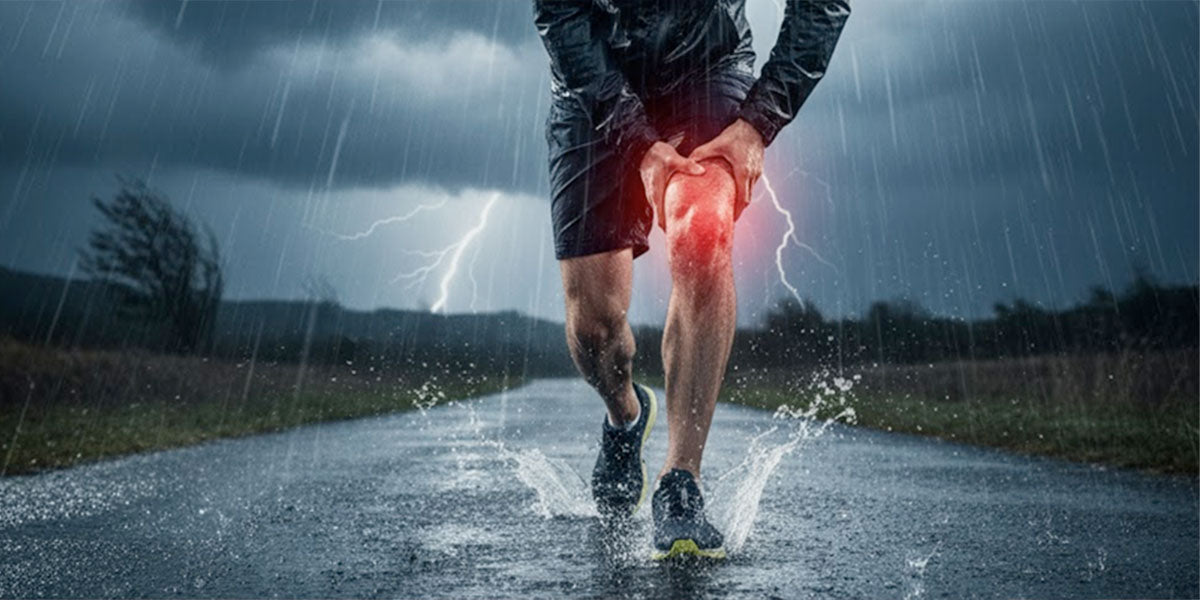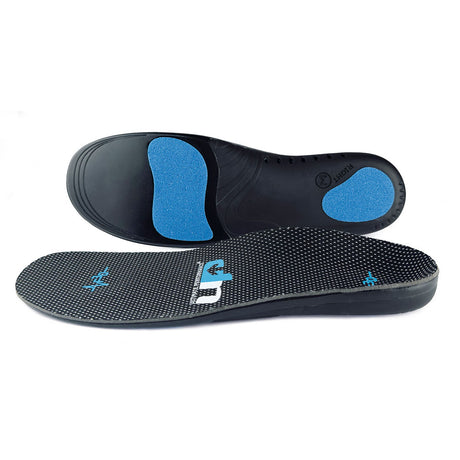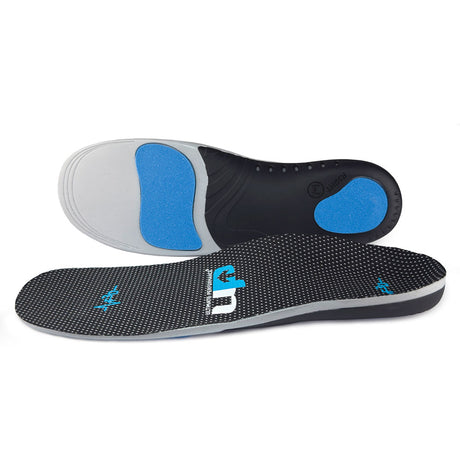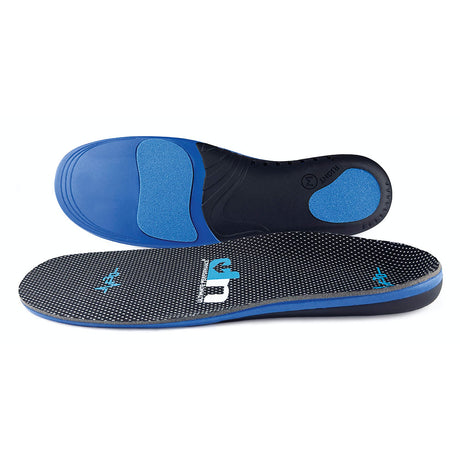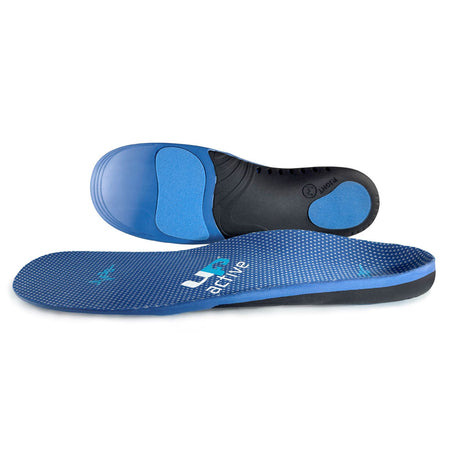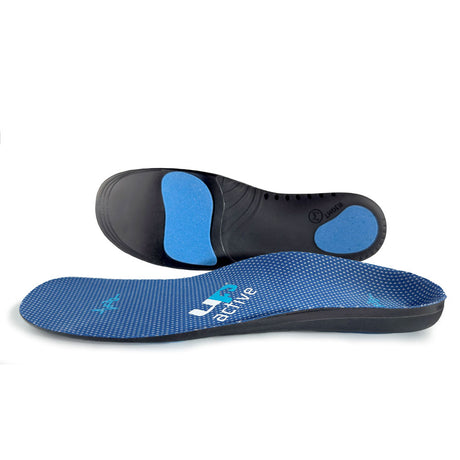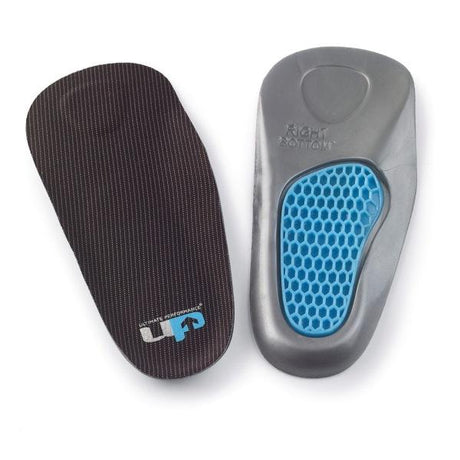Ultimate Performance Insoles help prevent and relieve knee pain by improving knee joint alignment and disipating shock. As a result, they mitigate the risk of many knee injuries.
Advanced F3D Support+ Insole - UP4570
Regular price £25.00Unit price /UnavailableAdvanced F3D Neutral Insole - UP4569
Regular price £20.00Unit price /UnavailableAdvanced F3D Cushion+ Insole - UP4568
Regular price £25.00Unit price /UnavailableActive F3D Cushion Insole - UP4567
Regular price £20.00Unit price /UnavailableActive F3D Support Insole - UP4571
Regular price £20.00Unit price /UnavailableUltimate Gel Heel & Arch Insole - UP4534
Regular price £12.00Unit price /Unavailable
Knee pain is one of the most common joint problems affecting people of all ages. Treatment depends on the specific injury or cause. However, selecting the right insoles for you can relieve knee pain, aid recovery and prevent future injury.
How Insoles Help with Knee Pain
Insoles work by improving how your feet, ankles, and knees align when you walk or run. If your feet roll inward (overpronation) or outward (supination), it can place extra strain on the knee joint. Specifically:
- Correcting foot posture – They realign the foot and ankle to support a healthier walking pattern.
- Distributing pressure evenly – Reduces stress on the inner or outer side of the knee.
- Absorbing shock – Cushioning materials lessen impact through the leg during movement.
- Supporting the arch – Helps stabilise the lower limb, especially for flat feet or high arches.
Common Causes of Knee Pain That Insoles Can Help
- Patellofemoral pain syndrome (runner’s knee)
- Osgood Schlatter disease
- Iliotibial band syndrome
- Osteoarthritis of the knee
- Overuse injuries from running or jumping
- Postural imbalances caused by flat feet or poor footwear
While insoles won’t “cure” these conditions, they can significantly reduce symptoms and help prevent further irritation.
Patella alignment & Q angle

Correct patella tracking is important to avoid knee injuries such as Patellofemoral pain syndrome. In particular, if you overpronate and your foot rolls in or flattens, this causes your lower leg to rotate inwards, which in turn alters knee alignment. Repeated rubbing of patella against the bone underneath causes pain and inflammation.
The Q angle of the knee is a measurement of the angle between the quadriceps muscles and the patella tendon. It provides useful information about the alignment of the knee joint.
Key features of Ultimate Performance insoles that help with knee pain

Here are the main technical features, and how they translate into knee-benefiting effects:
F3D Foam Damper
This is a full 3mm of damping foam layer which dissipates up to 95% of the shockwaves produced by each foot strike. Lower shock transmission means less repetitive micro-trauma to the knee (and other joints) with each step.
In practical terms: the knee sees less “jolt” from the ground-impact, reducing cumulative load and irritation.
Full-length PU Foam Core
Ultimate Performance Advanced Insoles feature a Polyurethane foam core for comfort and support across the whole foot. The Met Pad (metatarsal pad) spreads pressure across the forefoot, aiding better distribution of load.
By supporting arch height and forefoot pressure distribution, the insole improves foot posture and alignment, which helps the knee track more naturally and prevents abnormal loading.
TPU Brace
The insoles include a TPU (thermoplastic polyurethane) brace element for structural support.
This helps reduce excessive foot motion (e.g., over-pronation) that leads to knee valgus stress (knee collapsing inward) or other maladaptive loads. Ensuring the foot/ankle alignment is improved helps the knee align better during movement, reducing strain.
Trim-to-fit design
Ultimate Performance Advanced and Active insoles are full-length. Therefore, they replace the stock insole. You can easily trim to fit specialist shoes for running, walking, gym or everyday use.
Their versatility means consistent use across footwear, which is important in reducing knee-stress over time. Top tip - buy 2 or 3 pairs so you don't have to keep changing them!
How this translates into knee-pain benefit
Putting those features into context for knee pain, especially in cases of common complaints like patellofemoral pain syndrome (runner’s knee) or over-use knee loading:
By absorbing up-to ~95% of the shockwaves, the knee sees less repeated impact loading. Improved foot alignment and arch support reduce the inward or outward tilt of the leg during gait, meaning the knee is less stressed laterally/medially (inner/outer) and tracks better.
Controlled gait mechanics from the TPU brace help reduce abnormal rotational or valgus/varus forces on the knee, which can contribute to pain.
Full-foot support ensures load doesn’t concentrate in one part of the gait cycle (like forefoot or heel) thereby reducing compensatory stresses at the knee.
Top Tips
Choose the correct insole for your foot type: The Ultimate Performance range has different variants for over-pronation, neutral, and supination. Example: the “Advanced Support+” version is aimed at over-pronators (flat feet) needing more control.
Gradual adaptation: As with any orthotic or insole, it’s advised to wear them gradually over a week or two so your body adapts to the new gait mechanics.
Running Insights
Footwear compatibility: Ensure your shoes can accommodate the insole (i.e., removable footbed, enough depth) and that you trim to size if needed.
Complementary approach: Insoles address mechanical/impact aspects of knee pain, but if your knee pain is persistent, you may also need strengthening (e.g., quadriceps, glute medius), flexibility work (hamstrings/calf), and gait analysis.
Monitor symptoms: If your knee pain worsens after changing insoles, stop use and consult a physiotherapist or podiatrist. The alignment change may require a tailored follow-up.
Summary
If you are dealing with knee pain that is linked to foot posture, impact loading or gait mechanics, the Ultimate Performance insoles offer a well-engineered solution: they combine high shock absorption, full-foot support and gait-control architecture to reduce the mechanical load on the knee. For many athletes, active individuals standing for long hours, or those with recurring knee stress, these features mean the insoles can form a core part of the intervention.

